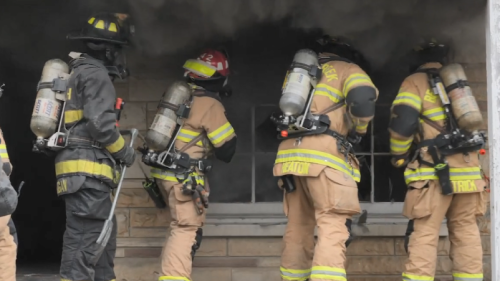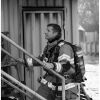“Start the fan” – a common order given at a typical fire scene. This directive usually corresponds with positive pressure ventilation (PPV) of a structure during or after fire suppression operations.
PPV is an effective tool for removing hazardous conditions and controlling atmospheres within a structure during firefighting. Here we’ll perform a deeper dive into this tactic so you can better understand how and when to deploy it on the fireground.
Positive pressure finds its place vs. negative pressure
PPV has been an adopted practice for quite some time. First implemented in the 1990s, PPV was touted as more effective than negative pressure ventilation, which was often fire department’s go-to method by use of “smoke ejectors.” Some departments might still carry these types of fans, which can be extremely useful on highly compartmentalized structures with a singular opening or in confined spaces. These fans are typically less powerful than their PPV blower counterparts, but under the right circumstances, every tool has a use.
Today, as organizations fight for valuable compartment space on apparatus, the positive pressure fans have become a coveted item – arguably a better bang-for-the-buck tool in terms of operational budget needs.
Positive pressure 101
The concept of positive pressure is basic in principle: A high-powered fan or blower is used to pressurize a compartment that has an identified outlet to control an exhaust flow for heat, smoke and toxic gases. I use the term “compartment” because we typically identify PPV for use during typical structural firefighting operations; however, it can be used in other firefighting or hazardous applications such as aircraft rescue firefighting (ARFF), maritime fires, industrial/large commercial buildings, high-rise buildings, subterranean locations, tunnels and confined spaces.
PPV fans produce a volume of airflow, which is measured in cubic feet per minute (cfm) – the amount of airflow that occurs through a space over a given amount of time. This metric is referenced in several systems, from large HVAC units to the exhaust fans found inside bathrooms.
Standard PPV blowers are manufactured to produce between approximately 7,000-24,000 cfm. This number is relative to the fan’s speed/power (greater speed/power output = higher cfm) and the overall diameter of the fan blades (larger = more cfm). Some manufacturers make blowers with throttle controls for the operator to adjust the flow rate; others offer single-speed blowers. Utilizing the fan’s throttle can allow the fan to run at an output that is titrated to the effectiveness of the desired ventilation, while prolonging the life of the energy source, such as gasoline- or battery-powered options.
PPV blowers can be powered by gasoline engines, electrical components or batteries. Pros and cons exist with every choice, but the advent of robust battery resources has made battery-powered units a highly desirable option. There are fan models that can integrate with already established battery supplies, such as rescue tools or portable lighting, and boast up to a 30-minute run time at full speed.
PPV is used to increase the effectiveness of horizontal openings that are ideally identified and established by the responders. As such, a blower is normally placed on the exterior of an opening for the structure. This is usually a doorway or advantageous opening. The operator must ensure that the entire opening is within this cone of airflow in order to maximize the effectiveness of this operation. The cone of airflow generated by the blower then travels through this opening, pressurizing the structure, which in turn forces the air to another opening.
This opening serves as an exhaust point, and this point is intended to be as close to the fire’s origin as possible. This permits the movement of undesirable products of combustion and heat to exit as fresh, cooler air is pushed into the structure from the exterior via the fan. This allows firefighters to rapidly clear the atmosphere of smoke and high temperatures that have been produced by the fire at a quicker speed.
PPV in today’s firefighting
Through important research, we now know that flow paths are ultimately being created by ventilation, regardless of the tactic. PPV in some circumstances is a supercharged flow path itself, which, performed without planning, could create unwanted conditions.
I recognize PPV as the controlled removal of heat and products of combustion after the fire is either knocked down or extinguished by firefighters. This is typically coordinated with communication between the fire attack companies and those tasked with ventilation or, ultimately, the IC. There is also overhaul being performed to ensure that the fire is not concealed in overhead compartments, walls or floor spaces.
Remember, we are forcefully supplying the fire with oxygen in modern fire environments that are usually ventilation-limited from the start when compared to our fuel-limited fires inside the leaky structures of yesteryear. Be aware of worsening conditions such as increased smoke production from the exhaust opening, other horizontal openings and/or roof vents. Increasing heat signatures on walls, ceiling and floors can indicate a hidden fire that is being supplied by your generated airflow. Take these indicators into consideration for discontinuing PPV until companies can check overhead spaces, including attics. Additionally, ensure that the original contents have been thoroughly extinguished, as smoldering fires inside mattresses and couches can easily flare up with its continuous supply of fresh air. Be especially cautious in activated sprinkler situations where there is an easy temptation to control the water flow and start the fan prior to really confirming that the fire is completely out rather than “in check.”
Be an airflow artist
PPV is not a mindless action but rather a coordinated art. Some of my best officers were masters of this craft, being able to view this process in 3D.
Remember, cfm is the measurement of airflow, but it will always travel in the path of least resistance, filling compartments and rooms. The size of the compartment, especially between the opening and exhaust point, will impact the effectiveness of PPV. Conversely, the number of compartments (think rooms) between the two points will also impact this process.
Take the time to close interior doors to manage the airflow’s path within the structure to lead it to its intended exhaust point. This process may have to be completed in a specifically coordinated order to completely ventilate multiple rooms, especially in apartments off a common hallway. In some commercial applications, PPV can be impacted by missing or dislodged ceiling tiles that may have been removed during the act of fire suppression. This can lead the created airflow to fill the void spaces above the fire compartment, rather than moving the air directly to the intended outlet. Reassess the blower’s performance as the incident progresses, and remember that to use the tool, you may also have to use the structure.
Pro-tip: If using PPV to ventilate a structure with a suspected or known natural gas leak, check the areas above the drop ceiling and take reading before and after ventilation, as PPV can push the flammable gas into these spaces or other void spaces. Take the time to evaluate these areas prior to clearing these types of emergencies.
Large structures and wind-driven conditions
When it comes to large structures, multiple fans can be used at the same entry point. As a general rule of thumb, if they have the same cfm output, then place them stacked (one over another) or tandem (side by side). If two fans are placed but have different cfm ratings, place the highest cfm blower approximately 3-4 feet behind the blower with the lower output. This will allow the more powerful fan to support the less powerful unit. In either circumstance, ensure that the cone of airflow completely covers the entry point that is chosen.
In high-rise situations, multiple fans may have to be used to achieve ventilation within the needed areas. Tactically, the primary areas usually involve the identified fire attack stairwell, the fire floor, the top floor and the evacuation stairwell. Obviously, the circumstances involving the fire incident will require decisions to be made by the IC, but the process for achieving PPV will require several fans, regardless of the areas chosen.
In my experience, we will initiate PPV for these structures at the fire attack stairwell of the lowest floor’s entryway. Another fan will be placed at the entranceway of the fire floor with coordination of the division supervisor. This will be used to support pressurization of the fire floor. The ventilation group will then evaluate the top floor to determine the ventilation need and will deploy another PPV fan to support operations if required. Otherwise, it may be necessary to place another fan inside the attack stairwell midway between the fire floor and lowest floor to support PPV inside these structures. Using this example, three or four blowers may be needed.
Furthermore, wind can significantly impact PPV operations. In high-rise incidents, wind will play a factor, especially as the height of the building increases. Controlling the impact created by this environment should be the priority ahead of establishing PPV on the fire floor. Keep in mind, structures may have a wind-facing side (windward) and a non-wind-facing side (leeward). After fire control, it may be a better practice to choose a leeward-side opening as the exhaust point for the PPV, as generally the wind-driven conditions on the fire floor may overpower the airflow created by a PPV blower. The same may be true for smaller residential structures and commercial buildings. Sometimes, choosing an entry path that is windward would aid the blower in achieving PPV. Although this may not create the most ideal pathways when compared to normal circumstances, use the aid of compartmentalization provided by interior doors to complete this tactic.
In certain circumstances, it may be more practical to use horizontal ventilation with the aid of natural wind. Think of it as working smarter, not harder while taking advantage of the conditions.
Final thoughts
PPV is an effective tactical tool for the fireground but one that requires more consideration than the on/off button of the blower. Train your team, think about the situation, and be successful with this process when it’s needed on the fireground.
Additionally, review this NIST study on PPV, which considered several reproduced fireground experiments. There are good case studies to review with generated models to bolster your knowledge in PPV.









